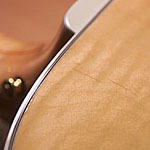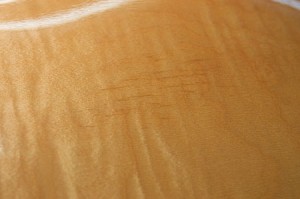 Maintaining your wooden instruments at an appropriate level of humidity year round is vital to their health and well-being. It is surprising how many owners of expensive instruments are unaware of this.
Maintaining your wooden instruments at an appropriate level of humidity year round is vital to their health and well-being. It is surprising how many owners of expensive instruments are unaware of this.
I suppose that the primary reason is a lack of educating customers at the time of sale. But I know players who ignore this issue even after being made aware of it. It takes just a little time and attention to keep your guitar properly hydrated during the dry times of the year, which for most of us is anytime the heat is on or the air conditioning is on. Both of these forms of climate control suck the humidity from the air.
It is a fact of life that wood is porous and it breaths. This is true even for wooden instruments and furniture that are finished with many coats of glossy lacquer. Such film finishes slow the process but there is no such thing as a finish that prevents wood from gaining and losing moisture seasonally. Also, something many guitar owners don’t consider is the fact that the inside of the guitar box remains unfinished while the outside is having lacquer applied.
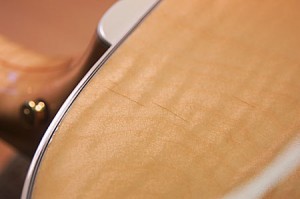 Thin wood breaths and moves more quickly than thick wood, and of course all the wood in a guitar is relatively thin… especially the back, sides, and top. A guitar made of solid wood must be kept within a certain humidity range in order for it to remain as it was designed and built. Failure to do this will result in changes to the guitar, none of which are good and which may lead to actual damage. This can include cracks in the finish or the wood itself, sharp fret ends due to the fretboard shrinking, poor action caused by the top sinking, bridges coming loose, and the internal braces breaking loose. All of this is easily preventable.
Thin wood breaths and moves more quickly than thick wood, and of course all the wood in a guitar is relatively thin… especially the back, sides, and top. A guitar made of solid wood must be kept within a certain humidity range in order for it to remain as it was designed and built. Failure to do this will result in changes to the guitar, none of which are good and which may lead to actual damage. This can include cracks in the finish or the wood itself, sharp fret ends due to the fretboard shrinking, poor action caused by the top sinking, bridges coming loose, and the internal braces breaking loose. All of this is easily preventable.
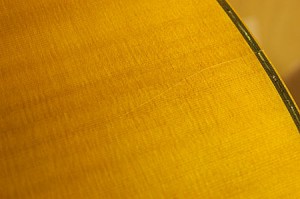 Preventing Damage Due to Dehydration
Preventing Damage Due to Dehydration
Please scroll to the bottom of this page to watch a comprehensive video on this topic, as well as two case studies of repairing damaged guitars.
If you have just one or two guitars, the first step is to buy more guitars. (Sorry, I just had to throw that in for us guitar addicts!) Seriously, for a single instrument using a device designed to add humidity to the cased guitar is the easiest way to go. There are several such humidifiers on the market and most of them are effective to some degree. I have used the D’Addario Humidipaks with good success; these hang into the sound hole, suspended by the strings. Other types require you to add water to them. Keep in mind that guitar cases are by no means air tight, and in a very dry environment these in-case humidifiers will have difficulty keeping up. But they are much better than nothing!
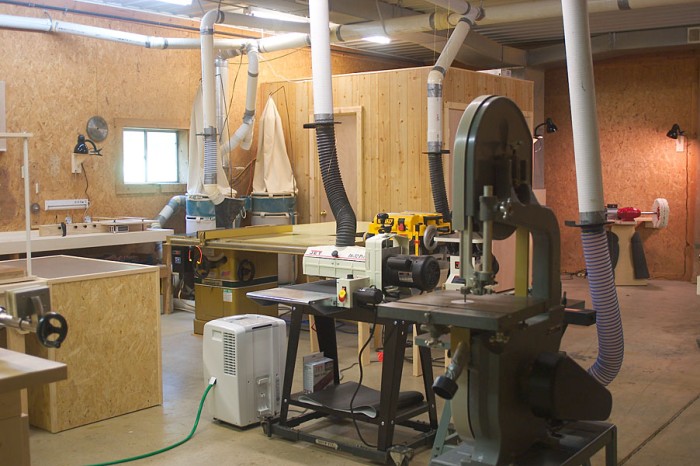
If you have enough guitars so that servicing the humidifiers gets tedious (or if you want the best solution to providing an ideal climate) the thing to do is to have a dedicated space for storing your instruments, one that you can regulate. This can be as simple as a closet or as nice as having a spare bedroom to use. I like using a room, since this allows you to have a place to play that keeps the guitar regulated even when out of the case. Regulating a room does not prevent you from using it for other purposes also, so there isn’t a down side. You’d be surprised at how well most guitars will stay in tune between playing sessions when kept in a stable environment. The ideal humidity level for acoustic instruments is 45-50% relative humidity. You should monitor this using a digital hygrometer made for cigar humidors, available on line for about $20. Avoid the department store types, especially the analog units with a dial indicator as they are so inaccurate as to be nearly useless for this purpose. Above all, don’t guess at the humidity level! I’ve talked with hundreds of customers who believed that their local climate was too humid when it was too dry, and vice versa. Get a digital hygrometer.
In the winter, maintain 50% humidity using a small inexpensive humidifier. Get one that has an adjustable setting which allows you to fine tune the humidity level. If you use distilled water at all times, whether you use a room humidifier or an in-case humidifier, you will thank yourself for the long service you get from the filter. Minerals in tap and well water will quickly clog any device that uses a filter. In the summer, air conditioning can quickly reduce humidity levels so you need to monitor your guitars then also. If you have an area that is not conditioned, then you will probably need to use a dehumidifier during the humid times of year. At the Dogwood Guitars shop, I maintain the shop at 45-50% year round using these methods.
If your guitar is suffering from excessive dehydration with the resulting symptoms described above, take it to a qualified luthier who can repair the damage and rehydrate the instrument. It can be surprising to see how well a dry guitar responds to hydration therapy. I strongly encourage you to avoid problems in the first place by monitoring and regulating the humidity for your instruments now.
A related topic is proper temperature, and here we have a bit more latitude. Consistent temperatures are more important than hitting a particular target number. Above all, avoid extremes of hot and cold. Freezing your guitar can damage both the glue and the finish; excessive heat softens glue, dehydrates, and can result in serious damage. Never leave your guitar in a car in the summer or winter, and warm it gradually inside the closed case when bringing it in from colder weather.
Proper humidity and moderate temperatures are the recipe for keeping your guitars in good condition for decades. Improper humidity is a leading cause of damage, and failure to monitor and regulate humidity will void the warranty on almost any factory or hand made guitar.
